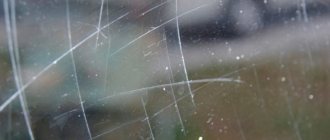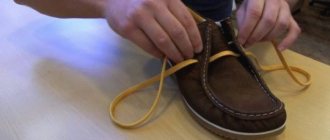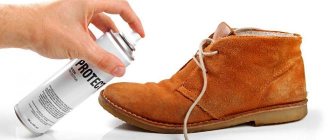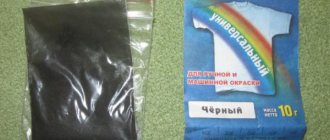For most women in the country, buying a new pair of shoes because the paint on the sole is damaged is a waste of money. You can go through many more seasons in good and favorite shoes if you know how to paint the heels of your boots at home. The methods are suitable for both elite and inexpensive couples: some of them are also used by professionals.
DIY heel painting.
Selection of coloring composition
Modern hardware stores offer a wide range of special paint for shoes. It is packaged in small bottles, the lid of which is equipped with a brush. The compositions are easy to use and inexpensive (average cost is 150-200 rubles per bottle). You can choose the color right in the store if you take the damaged boot with you.
In addition, it is convenient to use other types of dyes, including:
- special compositions for repairing leather products (liquid leather);
- acrylic aerosol paint in cans (for graffiti);
- car paint in cans (suitable for both metal and plastic), you can choose matte, glossy or even with a metallic effect;
- black nail polish;
- waterproof markers of the desired color (for painting over small scratches and paint chips).
How to paint heels?
Before you start painting, you need to take care to protect the part of the shoe that you do not plan to paint. Depending on the model, there may be a shiny insert at the base of the heel, the color of the leather is often different in color, or there is another decorative option that should not be exposed to heel paint.
You can use strips of construction tape (paper) to protect the skin near the edge of the sole. They easily take any shape, you can precisely lay them along the border of the heel, and, if necessary, cut off part of the adhesive tape with a sharp knife. You need to paste over the edge of the boot before preparing for restoration.
When the protective strip is glued, begin processing the heel itself:
- if the product was decorated with a covering (imitation of a set of thin layers of wood or other), the layer will have to be heated with a hairdryer and removed;
- It is advisable to completely remove old paint from plastic painted platforms using acetone solvents;
- Clean off the remaining glue and paint with fine sandpaper (for example, No. 4);
- degrease surfaces with alcohol.
Such careful preparation is necessary if the heel or sole with a wedge is severely damaged. Both boots will have to be painted so that they do not differ in appearance. If there are minor scratches, the defects are painted over without such complex manipulations.
When the shoes are prepared, place the boot in a plastic bag so as not to stain it with splashes or dirty hands. The part to be painted is left open (it is convenient to make a hole in the film). Dyes are applied in any way: with a brush or spray.
Painting is carried out in 2 layers. After applying the first, dry the product according to the instructions, and then apply a new coat of paint. After drying the boots again, remove the protective layers and, if necessary, use a thin brush to paint the areas at the base of the sole if they are covered with film.
Finishing
The skin was still a little damp when the husband moved on to the next stage of work. It didn't get wet, but as a result he had dye on his hands that washes off.
Start by cutting your large strip into two equal pieces. Apply glue liberally to the center of the heel.
Then apply the skin starting from the back. Pull, but do not tear, the wrap until it wraps around the sides and back of the heel itself.
Add glue if you need it. It can be easily cleaned with sandpaper if you suddenly see excess protruding in some places.
The drying process lasts about an hour.
Trim the leather around the heel, leaving about five millimeters as an allowance.
Make final cuts. On the sides of the heel (where it meets the flat inside) you can place a knife so that you get a clean cut.
The finishing touch to this project is to apply mink oil, which will add a nice shine not only to the heel, but to the entire shoe.
What to do if your heels are made of plastic?
On high-quality leather shoes, the soles are rarely painted. Manufacturers often cover wedges and stilettos with special thin leather, dyed to match the entire product, and on inexpensive models they use decorative film or paper. The plastic base of these heels is not painted and has a light yellow tint. If the leather is a different color, then even a small scratch will spoil the appearance of the shoes.
Small defects are painted over in the same way as in the previous case: shoe paint is applied with a brush directly to the leather and the layer of plastic underneath it. If the covering is severely damaged, then it is better to remove it entirely, proceeding in this way:
- under the insole, find the screws with which the heels are attached to the base;
- unscrew them and separate the heel from the boot or shoe;
- remove the heel from them (it is attached with glue and spikes), prying it with a knife;
- remove the remnants of the covering.
It is necessary to inspect the surface and level out deep defects with epoxy resin. Clean with sandpaper and paint in any way:
We paint the defects of the heels with black nail polish.
- spray from a can;
- using black nail polish;
- liquid skin, etc.
In this case, the heels are painted in 2 steps, as in the first case. This is necessary to achieve a smooth, slightly shiny surface. Paint in 2 layers will completely hide the light base.
After the studs have dried, they need to be attached to their original place by screwing self-tapping screws into the holes at the base of the heel. Lubricate the heel spikes with superglue and insert them into the grooves, press firmly for 10-20 seconds. Dry for 24 hours.
Decoration
Sometimes, when restoring boots or shoes with your own hands, it is appropriate to complement the coloring with decor, for example, by gluing small rhinestones to the heel. After applying the second coat of paint, this can be done by pressing the flat bases of the crystals onto the adhesive layer. If the crystals are very small (no more than 1 mm), then the dried heel is partially covered with a layer of varnish (it is better to take colorless). Then the surface is sprinkled with rhinestones or the varnished area is dipped in them. The rest of the glitter will fall off. When the surface is dry, the decorative part should be secured with a layer of colorless varnish.
Wedges and massive heels covered in denim will look original and always fashionable. A piece of fabric can be found among out-of-fashion items. The pattern of the heels can be made using masking tape, pasting them over their entire height.
Cut the tape to the plastic base under the sole and carefully straighten the paper. Transfer the pattern to the fabric, cut out the details and paste over the heels. At the base, you can cover the cuts with braid and carefully tuck it under the heel from below.
Decorating heels with your own hands.
A fashion trend in modern decor is the painted heel. You can come up with a drawing yourself or use templates. After painting the base color with a brush or sponge, flowers, lines, and geometric patterns are applied to the heels, guided by one’s own taste. When choosing shades for finishing, it is recommended to use 1-2 that match the color of the leather on the boots or shoes.
Read further:
Just a couple of decades ago, peeled heels were not considered a problem. Previously, this was easier - immediately after purchasing shoes, the hairpin was wrapped in a metal plate, which protected it from various damages. Even wealthy ladies sported “glasses” on their shoes.
Today this method of shoe restoration is not relevant, but there are many others that can hide a scratch from the eyes of others.
Shoe uppers: sewing and patching
Quite often you can encounter shoe ruptures. Even the most expensive shoes have this problem when a crack forms at the junction of the material and the sole. This causes severe discomfort, especially in rainy or snowy weather. Such defects can be easily repaired.
For example: a shoe has a hole along the sole line. To solve this problem we need a small piece of leather, that is, haberdashery. First, you need to warm up the problem area over a gas burner, then you need to carefully detach the sole from the material itself. Thus, we will get to the place of the gap, which needs to be turned inside out. We spread shoe glue on the inner surface and a piece of the patch, which we then slip inside. The next step is to connect the external break of the product to the patch. We leave everything in its place, and seal the sole with the covering with Demoxil. After 30 minutes, the defective area must be heated again, and then sharply connect the sole to the material and leave the shoes to dry.
This type of repair is suitable for absolutely any shoe material, be it leather, suede or canvas. The main thing is to choose the right patch.
How to fix a broken shoe sole?
A burst sole will require necessary and immediate measures, because if you continue with such a defect for some time, the situation can become much worse. This type of damage can be easily repaired yourself without going to a workshop. Glue, sandpaper, rubber and a press are the necessary materials to repair a pair of boots. Moreover, this small list can be easily found at home, or purchased at the nearest store.
Repairing hard and soft soles
Gluing the soles of shoes, sneakers or boots at home is not at all difficult if you use the most proven and reliable methods:
- We retreat 5 centimeters from the crack to the heel, drawing a parallel line. Then a few centimeters away from the toe, in order to rub the sole with sandpaper. It is worth noting that shoes with treads must be cleaned to zero. Apply any fast-acting glue onto the crack treated with gasoline or acetone. The insoles must be removed from the shoes in order to sew up the soles with strong threads. Lubricate the seam with glue, and when it dries, glue the outsole material to the surface, the same size as the rubber.
- We do the same with sandpaper and gasoline. We take a sharp knife and cut the edges of the sole to a depth of 1 mm, but at the same time retreat 5 mm towards the toe and heel. We take a ruler and measure the depth of the crack, after which we add one and a half centimeters to the result obtained.
We will need rubber from a bicycle or car inner tube. We cut out a rectangle and treat it on each side with strong shoe glue, after wiping it with acetone. The size of this insert must correspond to the size of the burst area. We bend the shoe so that the defect opens up more, then fill it with glue and let it dry. Under no circumstances should the edges of the crack be allowed to join. After this procedure, we glue a rubber strip and put the shoes under the press so that everything is properly held together.
- We degrease the defective area (regular nail polish remover is also suitable for this), and then rub its edges with sandpaper. We use a car or bicycle inner tube as a base, cutting out an insert with the appropriate length and width of the defect, also adding one and a half centimeters in reserve. Fill the damaged area and the rubber piece with glue and create a crack, after which we leave the shoes under pressure for a day.
These methods are mainly used to repair hard soles on winter boots and, as you may have already noticed, ordinary glue is unlikely to be sufficient. After all, if you just seal the crack, you will not only not correct the defect for a long time, you will most likely ruin the sole completely, which is why you will have to buy a new one. Replacing it is much more expensive, and you are unlikely to be able to do it yourself.
- When repairing soft soles, such as those found on sneakers and summer footwear, the situation is even simpler. The technology is the same - before the process, you should clean your shoes and wash them with a product that contains alcohol (for degreasing).
If a large hole has formed in your sole, you need to fill it with sickle. Use a solution of epoxy glue to fill the crack or hole with an even, thin layer (no more than 3mm). The solution will dry for several hours, but you should leave the shoes like this for a day, sticking masking tape on top of the sole to avoid deformation.
When the sole of a sneaker breaks in half, you should not try to seal it yourself, as this is unlikely to give the desired result. This requires a major overhaul, which only a master can do, because sports shoes are unlikely to withstand amateur efforts in such matters for long.
What can you do if your heel gets worn out?
If there is any trouble with your shoes, the simplest solution is to take a pair to a workshop. They will not only remove scratches from the heel, but also completely change it if necessary. But if for some reason you were unable to visit a specialist, you can repair the shoes yourself.
On boots
A scratch may partially expose the white frame of the entire heel. It doesn’t look very attractive, and it catches your eye instantly. The first thing to do is to straighten the covering and glue it so that it does not unravel further. Then the scratch is masked using improvised means.
- Permanent marker. This miracle marker lays down smoothly and, most importantly, does not wash off upon contact with water.
- Nail polish. They can only mask small damaged areas, since the composition does not apply very evenly.
- Acrylic paint. It is usually purchased in aerosol form or the usual version, which is applied with a watercolor brush. It lasts a long time, lays down smoothly, and dries quickly. If the heel is not black, then buy white paint, and along with it buy a color paste. The compositions are mixed to the desired shade, then applied.
- Car paint. This is a worthy alternative to acrylic dye, and in addition, it can be found everywhere.
Before painting the heel, you need to wash it, dry it thoroughly and degrease the surface with a solvent. To avoid getting the boot dirty, it is wrapped in a plastic bag. If there is no solvent, nail polish remover will do.
You cannot work with paint indoors. The respiratory organs must be protected with a respirator or at least a medical bandage.
On shoes
They can be restored in the same way as on boots. But if you try a little and show your imagination, you will be able to solve the problem in an original way.
- Paint the bottom of the heels in a contrasting color. Even a couple of bright stripes will transform the shoes and hide damage. And acrylic paint will help with this.
- You can disguise scratches with gold or silver glitter, placing them on glue. So the heel is sealed completely or only part of it.
- The scratch can be hidden by small beads, which are also used to cover the part completely or partially.
- Inlaying with small and large rhinestones is advisable if the heel on the shoes is peeled at the top. This option looks very elegant and turns ordinary shoes into evening ones.
- Ragged areas are also hidden under golden, silver or bronze paint. To do this, remove the remaining material from it, degrease the surface and cover it with paint from a spray can. It looks very interesting. For those who don't like glitter, you can take any other color.
- Shoes covered with braid with an ethnic pattern or some inscriptions look interesting.
On sandals
Summer is the time for bold outfits and creative shoes. By disguising a peeled heel, you can turn sandals into a designer exclusive. Just like shoes, they can be painted and updated with beads, sparkles or rhinestones. Other methods are also used:
- pasted over with floral fabric or guipure, thereby creating an excellent pair for a sundress or summer dress;
- mask the scratch with guipure to match your favorite blouse or top;
- you can paste cutouts from magazines or comics and then cover them with colorless varnish;
- tighten the heel with thin denim.
A few tricks to reduce your shoe size
One of the easiest ways is to take a pair to a workshop, where they will do this task perfectly. But shoemakers most often do not take on sneakers, boots and shoes made of leatherette or woven materials. You also need to take into account that this can cost a pretty penny. If you have time and desire, you can reduce the size using additional materials.
- Insoles are one of the simple ways to reduce not only the size, but also the volume of shoes. When one insoles are not enough, you can use two. The material from which the insoles are made is chosen depending on the time of year. For a winter pair of shoes, fur, felt or wool insoles are suitable. For demi-season boots, foam or synthetic insoles are usually used. If the insoles are intended for sports shoes, then they will reduce the size of the sneakers and have a shock-absorbing effect.
- Silicone inlays - can be purchased at almost any shoe store. Initially, they are intended to prevent slipping and rubbing of calluses. But they are also capable of narrowing the shoes a little. But to make high-heeled shoes smaller, it is better not to use them.
- Double-sided tape - you can stick it on the inside of the sole of the shoes, but you need to put them on bare feet, otherwise the tape will not stick. This method is mainly used by models during shows. Walking in such shoes for a long time is uncomfortable.
- Cotton wool, paper or fabric - placed in socks, it will help make shoes a size smaller. Our mothers and grandmothers also used this method, because back then they often bought shoes for children to grow into, or they got them from older brothers or sisters. But you need to keep in mind that this method is only suitable for closed-toed shoes.
Shock-absorbing orthopedic insoles are considered a good size reducer for closed shoes.
Nuances of repair depending on the material
The method of restoration largely depends on the material of the shoe. There is no single restoration recipe for leather, suede and patent leather shoes.
The patent heel has peeled off
On patent leather, scratches will be less noticeable if you lubricate them with Vaseline and buff with a soft cloth. Larger damage is painted over with acrylic paint or nail polish to match, and topped with colorless paint.
Leather heel peeling off
Scratches or nicks on shoes made of thin leather can be eliminated as follows:
- the material collected at the site of damage is slightly heated with a hairdryer to make it softer;
- smooth;
- BF-2 glue is applied to the damaged area and to the back of the skin;
- The skin is slightly stretched and pressed.
- Remains of glue are removed with a damp cloth, and areas with scratches are covered with a marker, varnish or paint in color.
The leather material must be pulled carefully so that new holes do not form.
The suede heel is peeling
You can mask scratches on suede using fine-grained sandpaper, salt and a hard eraser by simply rubbing the torn area. If painting is required, it is carried out with special products for suede.
Before work, wipe the suede with a cloth moistened with ammonia.
There are many ways to remove scratches from shoes, but if you can’t do it yourself, you can use special pads that are produced by many companies. As a last resort, a professional in a shoe shop will come to the rescue.
How do you restore heels to your shoes? I paint it myself and take it for repairs.
To be completely honest, domestic roads and sidewalks are not of the highest quality. Potholes and potholes are a problem faced not only by car owners, but also by beautiful girls who break the heels of their boots, getting into potholes and other troubles on the asphalt of megacities. Even new shoes can lose their attractive appearance after just a couple of weeks, so it’s important to know how to restore it to them. Even specialists in specialized shoe workshops are not always able to properly repair a heel, and the repair itself is not a cheap pleasure. That is why we suggest finding out how you can restore your heels by painting them at home.
How to repair cracked leather on shoes - repair methods and available tools
Leather shoes require careful cleaning and drying, otherwise they will become deformed. To maintain the appearance of your shoes, clean them after each wear. If the leather on your shoes is cracked, has lost its shine and has scratches, do not rush to get rid of it. There are many ways that will return it to its marketable appearance and allow it to be used for many more years.
How to repair cracked leather
If you do not pay proper attention to shoe care, cracks will appear on its surface.
To prevent shoes from deforming during storage, the toe is usually stuffed with paper, and thick cardboard is placed in the boot.
After each wear, wipe your shoes with a damp cloth and mask cracks with a special cream.
Fish oil can make shoes more water resistant. Light-colored boots and boots are treated with a soft brush, pre-moistened in warm water. Afterwards, the shoes are washed and dried naturally. As a preventive measure, it is worth wiping some steam with castor oil. The remaining oil is removed with cotton wool and rubbed with a velvet sponge.
You can get rid of cracks in any shoes using shoe care products. Water-repellent agents prevent the formation of cracks. The product is covered with a thin layer of cream to remove moisture. After this, the shoes are polished. A traditional means for treating leather products, shoe polish, protects it from external irritants.
Repairing boots at home
If the sole of your shoes has become unusable, then proceed to repair it. The most effective means include special glue for shoe restoration. To work, you will also need a knife, alcohol, clean cloth, newspaper, and a bag.
Lay out newspaper as a work surface. Treat the sole with a cloth soaked in an alcohol solution. If possible, scrape off the old glue with sandpaper.
Apply glue on all sides so that it is evenly distributed over all irregularities. Apply pressure to the torn areas. To remove glue, use alcohol-based products.
Wrap the shoes in a bag and weigh them down with a heavy weight, for example, a book. Check that the tear area is carefully pressed. Leave the glue to dry for two days.
How to seal burst boots with liquid leather
Often, when walking, we catch our foot on a stone or other obstacle, and our shoes tear. However, if you have liquid skin on hand, then there is no need to worry.
The principle of working with it is as follows:
1. Dry the boots well, and then remove pieces of leather and threads. To do this, use a sharp knife.
How to restore boot heels?
Before you begin restoration, you need to prepare equipment, which can be found in any store:
- Plastic bag.
- Sponge.
- Spray paint (automotive).
- Solvent.
How to paint a heel at home:
- Wrap the boot in a bag, protecting it from paint. If the heel and shoes are black, then creating a protective layer is not necessary.
- Degrease the surface of the heel by wiping it with solvent.
- We paint the heel outside or in a well-ventilated area.
Important! In order to buy car paint, you need to go to a special store, where the range of products is large enough and you can find a suitable shade. It is better to give preference to acrylic paint, as it dries quickly and goes on smoothly. One spray can can paint up to 5 pairs of boots.
Coloring plastic heels
If black boots with plastic heels have lost their attractive appearance, then it’s not a problem. Many girls face this problem, because the black coating quickly peels off, and behind it you can see the white plastic that acts as a base. If the shoes are intact and only the heel is damaged, then it needs to be painted with paint (regular or spray).
We paint plastic heels at home:
- Using black nail polish. First you need to degrease the surface with a solvent (cologne or alcohol), and then apply paint with a brush.
- Using black acrylic paint.
- If the boots are not with heels, but with high stilettos, then they can be covered with leather rather than painted.
Note
If you want a quick fix and don't want to deal with leather, retailers sell special wraps for heels. I can't vouch for this material, but it comes in different types. You can also glue the leather sections together and simply spray paint the heels. Honestly, I doubt many people will notice the black heel if it's pretty close to the same sheen it was originally and your paint job is good.
Repair of paper covered heels
Despite the fact that prices are constantly rising, the quality does not improve. Unscrupulous shoe manufacturers are trying to save money in every possible way, so they do not use multi-colored plastic, but cover the heel with special paper. However, no matter what it is, its quality leaves much to be desired, so the shoes quickly peel off and lose their attractive appearance after just a couple of trips outside.
In this case, painting the heels will also help, if desired. Stages of painting heels covered with paper:
- Prepare equipment: nail file, lint-free cloth, solvent, hair dryer and paint.
- Heat the heel with a hairdryer and remove the paper.
- Degrease the surface with a cloth soaked in solvent and remove any adhesive residue.
- Paint the heel in 2-3 layers.
- Wait a couple of hours.
How to restore completely damaged heels?
In fact, bad manufacturers and roads are not the only problems you have to face. Very often boots and their heels become unusable due to external factors. For example, heels can be pulled off by a cat or chewed by a dog. If it’s a shame to throw away new boots with completely damaged heels, then something needs to be done.
The repair includes the following stages:
- Tear off the insole.
- Unscrew the screws.
- Remove the heel.
- Open the heels.
- Clean off the old covering.
- Cover visible defects with epoxy paint.
- We sand the surface and cover it with glue.
- We cover the heel with leather and return it to its place using new heels.
- We enjoy a job well done!
Do-it-yourself major restoration
Major restoration with your own hands is quite possible and real. If for any reason your shoes become unusable, for example, this could be the result of being bitten by a pet, then do not rush to throw them in the trash. No matter how dire the situation is, you can find a way to improve it.
To begin the repair, open the insole completely, open the visible screws and disconnect the heels. After this, open the heels and strip off the old covering. If there are traces of teeth or claws on your shoes, carefully cover all damage with epoxy paint. Sand the surface thoroughly and then apply a thin layer of glue to later glue the leather to this place for covering. To complete the procedure, reattach the heel and install new heels. If you need the shoes as soon as possible, you can use a hairdryer to dry the glue.











